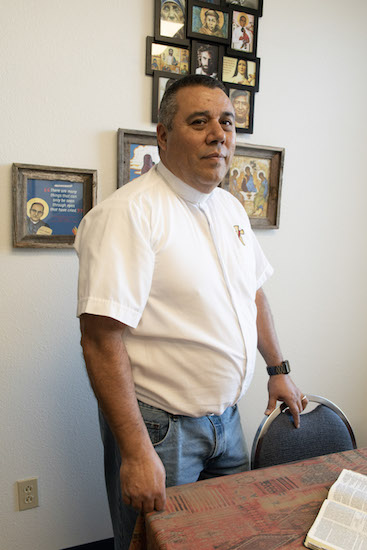Nearly every day, U.S. Immigration and Customs Enforcement releases asylum-seeking migrants “on their own recognizance,” strapped with GPS ankle monitors and a notice to appear at an ICE facility while their claims are processed.The migrants – mostly parents with children – have often made arduous journeys from Central America and spent days or weeks in detention. They are tired, hungry and disoriented and need shelter before they head to their next destination.

Lonnie Briseño is a deacon in the Catholic Diocese of Las Cruces and organizer of Project Oak Tree, a three-year-old effort that unites faith-based organizations to provide food, clothing and shelter to migrants in southern New Mexico. He spoke with Searchlight about the project.
What are the origins of Project Oak Tree?
Ruben [Garcia, of El Paso’s immigrant shelter Annunciation House] reached out to [the former Las Cruces] Bishop Oscar Cantu. Annunciation House was overwhelmed. We called it “Project Oak Tree” because the bishop didn’t want to offend any faith-based group. So we went to the Old Testament and found the story of the oak tree.
What’s the story?
Abraham was sitting outside his tent. There were three strangers coming on the road. He brought them in to rest under an oak tree and provided them water, a meal to eat and rest. When you think about it, that’s what we do.
You have also taken migrant families into your own home.
In 2015 or 2016, we got the call again [from Annunciation House]. At that point, we could not find a church that was willing to do it. I thought, let’s use a different model. Let’s look at getting some host families who would be willing to take [migrants] into their home. So me and my wife did, and we loved it.
I would rather do that than the shelter, because you get to know them. The stories move your heart. A lady who took a family home said that when she showed them their room, she had a picture of Our Lady of Guadalupe and as soon as [the father] saw it, he fell on his knees and started crying. There was that connection – it was the same Mary in his country who was with him here.
Who are the people you are helping?
They are men and women, mostly from Central America, who have some connection to the United States. They are tired. They are hungry. They have been stripped of their human dignity. I was taking a man to the airport, and I asked him, “What was the most difficult part of your journey?” I thought, it’s going to definitely be something that happened in Mexico. He said, “When I was incarcerated [by ICE]. I have never been the kind of person to end up in a jail. I am a g